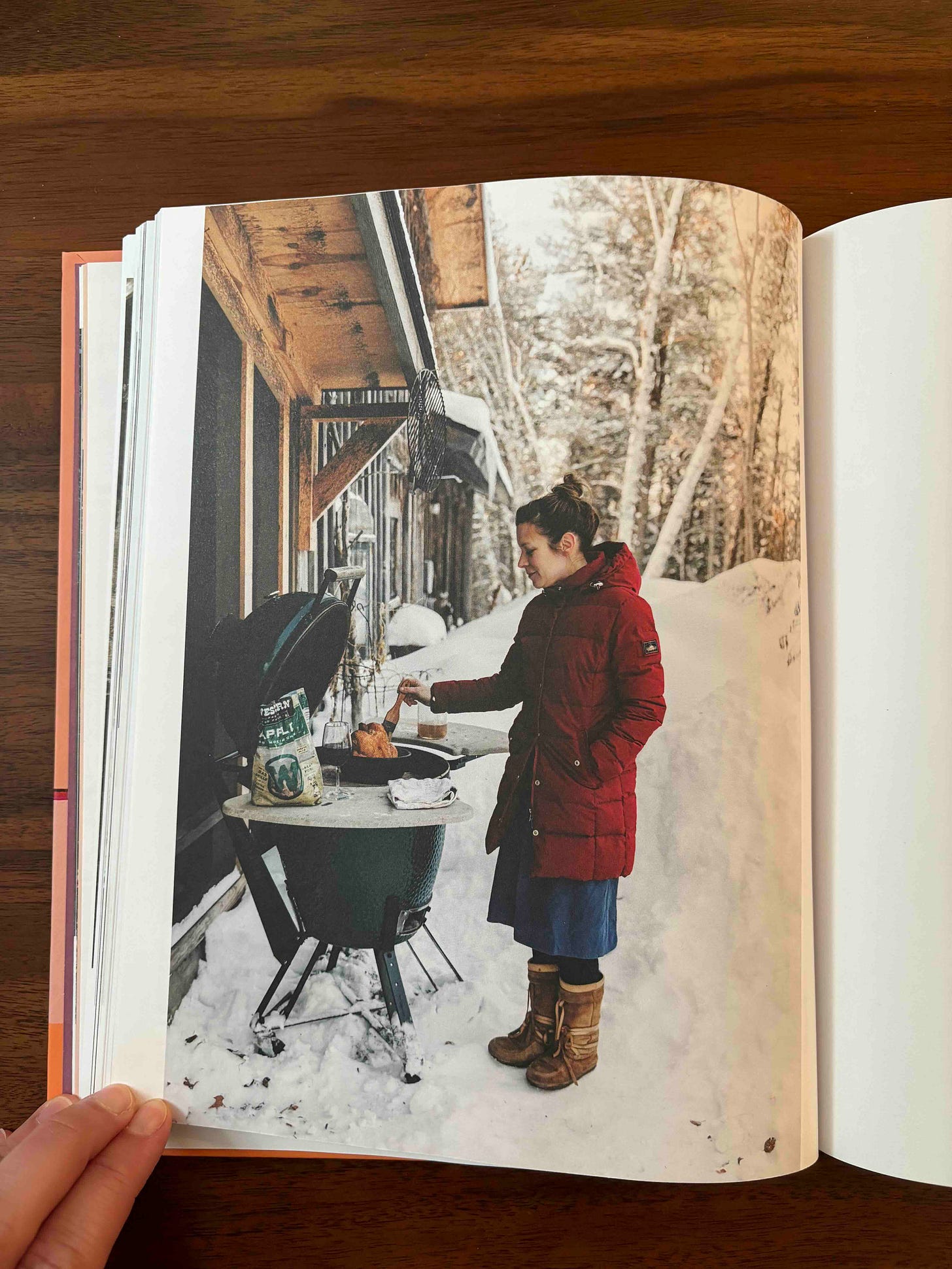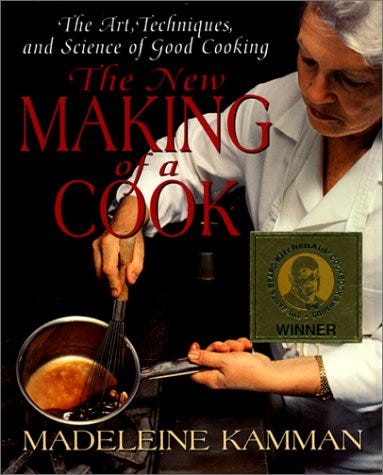So many of the guests here on my pretend talk show (a.k.a. my Substack) have said they read cookbooks cover to cover. I do as well, and I honestly can’t remember one bringing me more pleasure over the last five years than Company: The Radically Casual Art of Cooking for Others (Bookshop/Amazon) by Amy Thielen.
I mentioned the book in my Q&A; in hers, Kate Leahy said Company “is so beautifully written that people could teach food writing out of it.” And numerous people have brought it up in the comments sections of various posts.
There’s so much to talk about with this book. Let’s start with the subtitle, “The Radically Casual Art of Cooking for Others.” Radically casual! That one word says so much—this isn’t going to be your typical entertaining book. But it isn’t the food that’s casual, it’s all the other trappings. In the introduction Amy writes:
I’m not concerned about napkin rings or guest lists or wine pairings or expensive Italian charcuterie (which I couldn’t buy here anyway). This book focuses on the precious pre-party hours, when we’re standing in the dim late-afternoon kitchen holding a zucchini and having an internal debate: Should we poach it and sauce it with muddled mint oil, or slice it raw for carpaccio? Or should we make something saucier instead, like creamed corn?
The food is decidedly un-casual, in my opinion. The book is organized into various menus by group size, and you can tell that the menus are like elegant puzzles Amy put together for us. She’s thought about temperature and textures and the juxtaposition of big flavors and soothing background players. There’s a precision to her choices—she was a fine dining chef after all—even if the overall effect is casual and generous. Many of the recipes require real time and effort on the part of the cook; this isn’t a book about “quick and easy” entertaining. But in the world of this book that’s how it should be; it’s about the pleasure of cooking for the people you love.
Amy lives in rural Minnesota, where she says, “In-house entertaining is more than a way of life—it’s pretty much our only option.” The place informs so much of the book, and there’s also this notion of thrift that’s threaded throughout, starting with a page in the introduction titled, “We Should Probably Talk About Money: A little penny-pinching makes it all possible.”
I could go on and on about everything I love about this book, but you’d probably rather hear from Amy. She’s a two time James Beard Award-winner and also the author of The New Midwestern Table (Bookshop/Amazon) and the memoir Give a Girl a Knife (Bookshop/Amazon).
Amy is currently producing and hosting Ham Radio with her local public radio station, KAXE. The show, which broadcasts live and then is released as a podcast, is a mix of interviews, call-in, and live conversation. It is, in a word, a balm. Amy and her co-host talk to friends and neighbors about topics like family reunion food traditions, frugal cooking projects, and keeping regional recipes alive. It’s welcoming and gentle, and these days that feels pretty radical. Listen here or wherever you get your podcasts.
Thanks for chatting, Amy!
The Cookbookery Q&A with Amy Thielen
About how many cookbooks do you own?
AT: Last time I counted was eight years or so ago, and I had just over 400, so I’m curious. (Counting.) Okay, I have 650 now. That feels like a manageable growth rate, but still, I’m running out of bookshelves.
How do you organize them?
AT: A few years ago, I started alphabetizing them by author’s last name and I don’t regret it—it makes looking for a quick quote or reference actually possible, whereas before I’d spend a half hour looking for a certain book, losing my train of thought in the process. But alphabetizing has its own consequences. There’s always a huge pile of books on the banquette between my office and kitchen, patiently waiting for me to shelve them. And I occasionally have to migrate whole sections. When the Bs and Cs got too big, I had to move one shelf over, and now the Zs are threatening to push the last two shelves of books that don’t have recognizable authors—like the community and church cookbooks, and the regional anthologies—out of the office entirely.
What would you say to someone who questions why cookbooks still matter in our "digital age"?
AT: Let me count the ways—or try to. First, SEO. When I search for a chocolate cake recipe, all I see are bloggers’ recipes. I’ve tried searching “chef recipe,” and that usually leads to a subscription-only block. And when I go looking for a particular chef or cookbook author’s recipe I vaguely remember—say, Judy Rodgers’ zucchini pickles, or that Savoie walnut cake from Madeleine Kamman’s When French Women Cook (Bookshop/Amazon)—it’s rarely ever on the internet. Publishers release only so many recipes onto the internet, and protect the rest. (And, professionally, I thank them for that.)
Secondly, I like to page through a book when I’m searching for inspiration. If I feel like making something Japanese-ish, I’ll pull down Nancy Singleton Hachisu, or Japanese Cooking: A Simple Art (Bookshop/Amazon) by Shizuo Tsuji. Third, you can’t take a search engine to bed. And that’s how I like to consume cookbooks, in book form, before I go to sleep. So that the ideas slide into my dreams, and become, hopefully, the next day’s inspiration.
What are you most proud of when it comes to Company?
AT: Recipe-wise, I’m really proud of Lemon Nemesis, a frozen lemon semifreddo cake, which was the result of many years of trial and error and, because of that, ended up being pretty original, I think.
Writing-wise, I was thrilled to hear that some of the initial reviewers and readers thought the book was funny. Sometimes late at night I’d write something that would crack me up, and I’d think “This is so stupid, Melanie (my editor) will cut this for sure.” But I’d leave it in anyway, as more of a private joke between us than anything else. (I took over five years to write this cookbook, so we had time to develop our own inside jokes.) It was a bit of a nail-biter to go public, but every time someone says, “This book is funny!” my ego swells, and I dream of a life in comedy.
I am obsessed with the photos in the book. They're a mix of food photos and "lifestyle" shots, but they all feel so real. (There's an adorable one of you grilling in the snow in your coat and boots, although the mom in me wanted you to also be wearing a hat.) How did you think about the visual style in the book?
AT: The Company (Bookshop/Amazon) photo shoots were such a blast. My photographer, Kristin Teig, is just so talented, and versatile, and almost disarmingly humble. She’s so incredibly nice, but at the same time, visionary, which is such an incredible combination. My food stylist, my prop stylist, my longtime assistants . . . we had such a great time, and I think it shows. We didn’t plan for the photo you mentioned to be used in the book; like, I didn’t get out the curling iron that day, I was just cooking alongside my stylist. Sometimes those shots are better.
What is the first cookbook you remember cooking out of?
AT: Betty Crocker, baby! I have my mom’s copy, the one she used most during my childhood, and the photos bring back so many memories. I also remember cooking a lot out of my mom’s recipe box, making things like “Judy Ackerman’s Chocolate Cake” and “Great Aunt Helen’s Port Wine Cranberry Jello.” Then, after college, when I was cooking on my own, I was all about Vegetarian Cooking for Everyone (Bookshop/Amazon) by Deborah Madison. Possibly because I’d grown up eating so much meat. (My mom is a master at cooking meat.)
What kind of cookbook reader/user are you?
AT: I use them for inspiration, pulling down 8 to 10 in the mornings and stacking them all around me, and then I head to the kitchen and spin off from there. Ironically, I suppose, I rarely follow recipes. Unless I’m baking, I don’t like to weigh or time things. It takes too long!
What do you find boring in a cookbook?
AT: I like a little personality in the method text. When the method hews too close to “house style,” or when every direction is “cook until brown, about five minutes,” I feel like the author hasn’t cooked the dish enough to really get to know it.
What is a cookbook that changed the way you cook?
AT: Madeleine Kamman’s The New Making of a Cook. I absorbed this book just before going to cooking school, and honestly, it should be a prerequisite.
What is a cookbook that totally transports you?
AT: Ironically, older cookbooks that don’t have photos are the most transporting for me, because the recipe becomes a fictional world. For example, Elizabeth David’s books. No photos, short method text, totally evocative.
What's a cookbook that you think didn't get enough attention?
AT: I’m sure it received attention when published, but I don’t see it mentioned very often these days: Fields of Greens by Annie Somerville. This is the second Greens cookbook and such a classic.
You’re only allowed to cook from three books (aside from your own) for the rest of your life. What are they?
AT: Ada Boni’s Italian Regional Cooking. It’s a huge book—I mean it’s the size of an old-school menu—that has no, or very few headnotes. The progression and profusion of recipes, from the butter and lard of Piedmont to the tomatoes and olive oil of Sicily, tell the whole story.
Does the entire Time-Life Cookbook Series count as one book? Each one is written by a different author, with a distinctive voice. Spain is a fave.
Nigel Slater’s Notes from the Larder: A Kitchen Diary with Recipes (Bookshop/Amazon…note that the Bookshop link is for an e-book). Perfection.
Interview has been lightly edited. If you purchase a book through one of these links, I may receive a small commission.
More to Nibble On
A list of Six Cookbooks for Frugal Cooking, including Bare Minimum Dinners. A couple others on this list are go-to’s for me, too, and reading the comments warmed my little heart. Thanks Robynne!
This was announced a couple of weeks ago, but ICYMI, the New York Times has a cookie book out this fall.
Happy pub week to Braided Heritage: Recipes and Stories on the Origin of American Cuisine by Jessica B. Harris. Listen to Dr. Harris talk about her book on the Tinfoil Swans podcast; go here for highlights.
NYT Bestsellers: The Wishbone Kitchen Cookbook, on the list for the fifth week, at #4
Thanks for reading! If you enjoyed this post please tap the heart button, restack, or share with another cookbook fan.











I can’t help but notice was a beautiful home she has! I want to see more!!!
Love reading this interview!